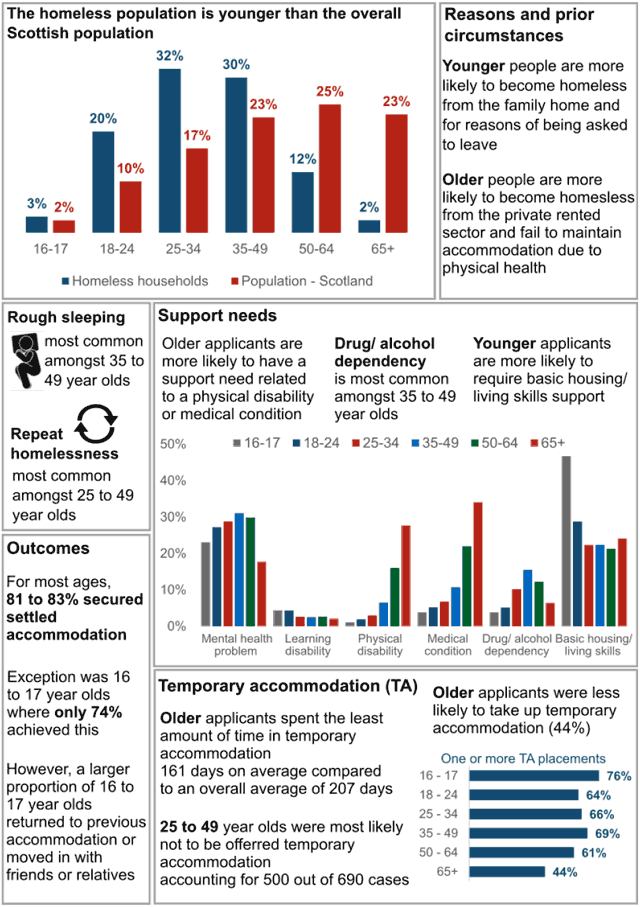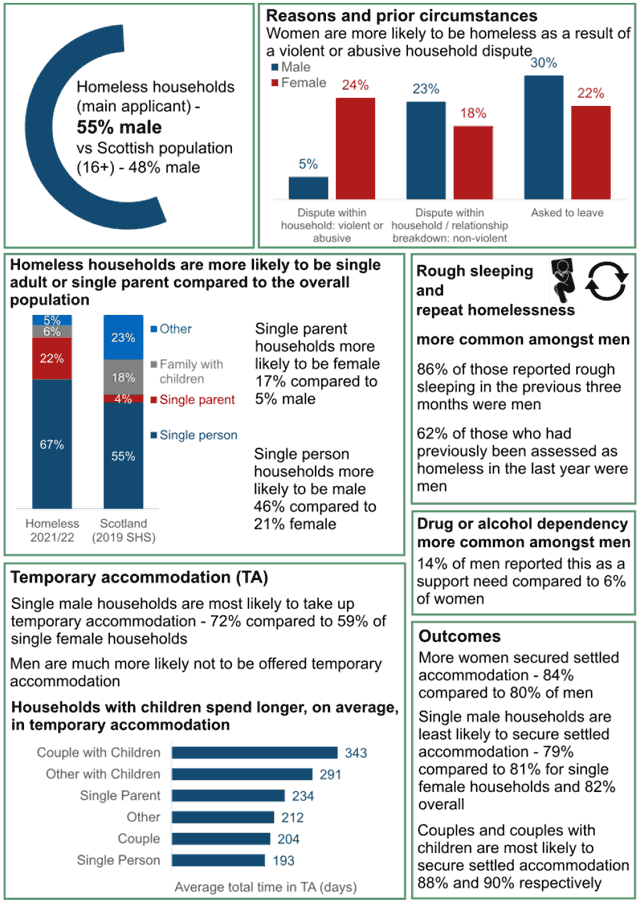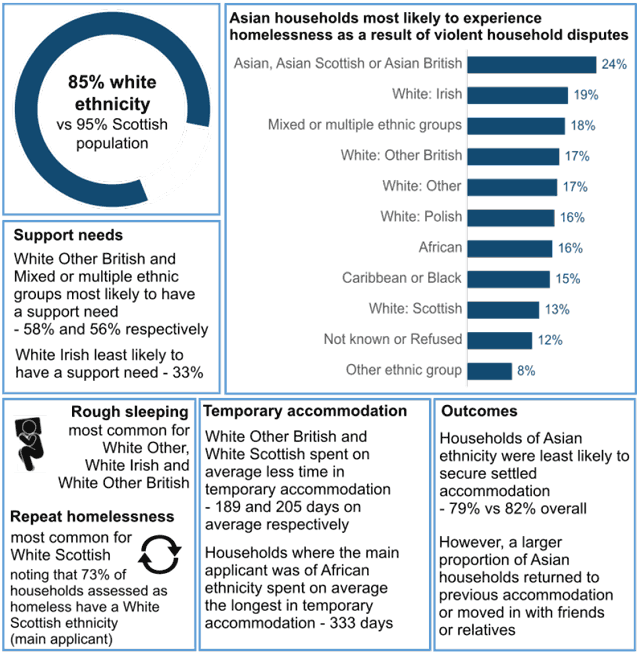Homelessness in Scotland: 2021/22
This statistics bulletin provides information on homelessness in Scotland in the period from 1 April 2021 to 31 March 2022, alongside historical data.
Characteristics of the homeless population
The following findings provide a broad overview of the characteristics of the homeless population and how they compare to the Scottish (adult) population. They highlight key findings where differences exist for aspects of homelessness across the characteristics of age, gender and ethnicity. Characteristics are based on those of the main applicant.
Although data is captured for the main applicant and a second applicant where applicable, findings are based on the characteristics of the main applicant only for ease of reporting. Given the majority of homeless households only contain one adult, this only affects 10% of all households where there are two or more adults.
The characteristics of a household are initially collected by the local authority at the application stage. While it is possible for these characteristics to change between application and case closure, it may not be practical for the data collection to be updated to reflect these changes. Therefore, for a small number of households, the characteristics information reported may be out of date. This is most likely to affect household composition.
Detailed figures are available in accompanying equalities tables. Caution should be taken when interpreting results based on small numbers of households. This is particularly true when comparing results for different ethnic groups.
Age

- The homeless population is younger than the overall adult Scottish population (16+)
- Reasons and prior circumstances
- Younger people are more likely to become homeless from the family home and for reasons of being asked to leave
- Older people are more likely to become homeless from the private rented sector and fail to maintain accommodation due to physical health
- Rough sleeping is most common amongst 35 to 49 year olds
- Repeat homelessness is most common amongst 25 to 49 year olds
- Support needs
- Older applicants are more likely to have a support need related to a physical disability or medical condition
- Drug or alcohol dependency is most common amongst 35 to 49 year olds
- Younger applications are more likely to require basic housing or living skills support
- Outcomes
- For most ages, 81 to 83% secured settled accommodation
- The exception was 16 to 17 year olds where only 74% secured settled accommodation
- However, a larger proportion of 16 to 17 year olds returned to previous accommodation or moved in with friends or relatives
- Temporary accommodation
- Older applicants spent the least amount of time in temporary accommodation – 161 days on average compared to an overall average of 207 days
- 25 to 49 year olds were most likely not to be offered temporary accommodation – accounting for 500 out of 690 cases
- Older applicants were less likely to take up temporary accommodation (44%)
Gender and household type

- 55% of homeless households (main applicant) are male compared to 48% of the adult Scottish population
- Reasons and prior circumstances
- Women are more likely to be homeless as a result of a violent or abusive household dispute
- Men are more likely to be homeless as a result of a non-violent household dispute or being asked to leave
- Homeless households are more likely to be single adult or single parent compared to the overall population
- Single parent households are more likely to be female – 17% compared to 5% male
- Single person households more likely to be male – 46% compared to 21% female
- Rough sleeping and repeat homelessness is more common amongst men
- 86% of those reported rough sleeping in the previous three months were men
- 62% of those who had previously been assessed as homeless in the last year were men
- Drug or alcohol dependency is more common amongst men
- 14% of men reported this as a support need compared to 6% of women
- Temporary accommodation
- Single male households are most likely to take up temporary accommodation – 72% compared to 59% of single female households
- Men are much more likely not to be offered temporary accommodation
- Households with children spend much longer, on average, in temporary accommodation
- Outcomes
- More women secures settled accommodation – 84% compared to 80% of men
- Single male households are least likely to secure settled accommodation – 79% compared to 81% for single female households and 82% overall
- Couples and couples with children are most likely to secure settled accommodation – 88% and 90% respectively
Ethnicity

- 85% of homeless households (main applicant) are of white ethnicity compared to 95% of the adult Scottish population
- Support needs
- White other British and mixed or multiple ethnic groups most likely to have a support need – 58% and 56% respectively
- White Irish least likely to have a support need – 33%
- Asian households most likely to experience homelessness as a result of violent household disputes
- Rough sleeping most common for White other, White Irish and White other British
- Repeat homelessness most common for White Scottish – noting that 73% of households assessed as homeless have a White Scottish ethnicity (main applicant)
- Temporary accommodation
- White other British and White Scottish spent on average less time in temporary accommodation – 189 and 205 days on average respectively
- Households where the main applicant was of African ethnicity spent on average the longest in temporary accommodation – 333 days
- Outcomes
- Households of Asian ethnicity were least likely to secure settles accommodation – 79% compared to 82% overall
- However, a larger proportion of Asian households returned to previous accommodation or moved in with friends or relatives
Contact
There is a problem
Thanks for your feedback